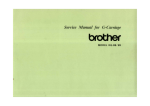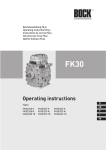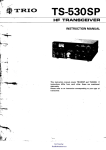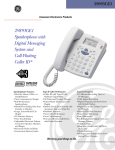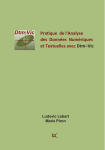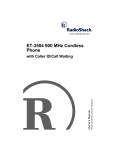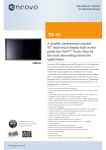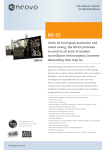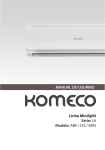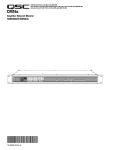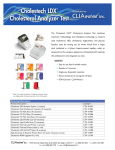Download User Manual
Transcript
www.neo-laser.com The neoV1064 Application Manual •Nail Fungus •Warts 2 DHF-001-R-023 neoV1064 Application Manual European Authorized Representative: MEDNET GmbH Borkstr 10, 48163 Munster, GERMANY 1023 CON T E N T INHALT Lasers Safety . . . . . . . . . . . . . . . . . . . . . . . . . . . . . . . 4 Device Overview . . . . . . . . . . . . . . . . . . . . . . . . . . . . 7 Optical Handpieces . . . . . . . . . . . . . . . . . . . . . . . . . . . 9 Nail Fungus . . . . . . . . . . . . . . . . . . . . . . . . . . . . . . . 11 Warts . . . . . . . . . . . . . . . . . . . . . . . . . . . . . . . . . . .15 © 2014 neoLaser. Alle Rechte vorbehalten. Namen anderer hier genannter Firmen und Produkte sind Marken ihrer jeweiligen Rechtsinhaber. Jede Nutzung des Materials, einschließlich der Vervielfältigung im Ganzen oder in Teilen, bedarf schriftlicher Genehmigung von neoLaser. Es wurden alle Anstrengungen unternommen, um sicherzustellen, dass die in diesem Handbuch aufgeführten Informationen korrekt und auf dem neusten Stand sind. neoLaser übernimmt jedoch keine Gewähr für die Richtigkeit des Inhalts dieses Handbuchs und haftet nicht für persönlichen Schäden oder Verletzungen, die direkt oder indirekt verursacht werden, allein durch die Nutzung dieses Dokuments. Im Zweifelsfall wenden Sie sich bitte vor Benutzung dieses Geräts an neoLaser. Mai 2014 ENGLISCH © 2014 neoLaser - all rights reserved. Names other here named carrier companies or products are trademarks theirs respective holder of rights. Any use of the material, including reproduction in whole or in part, requires permission in writing from neoLaser. While every endeavour has been taken by the authors to ensure the information in this document is accurate and up to date. neoLaser shall not be liable for any personal damage or injury caused directly or indirectly, by solely using this document. In case of any doubt, please contact neoLaser before using the device. May 2014 © neoLaser 2014 3 LASERS SAFETY THERAPY INDICATIONS 1. This manual covers various podiatry applications approved for use with the neoV laser; manual is designed to assist both the “beginner” and “experienced” users. 2. Clinical information detailed in this manual is intended to be used by a healthcare professional who posses relevant medical background, as well basic knowledge with medical lasers. 3. It is strongly advisable to refer to appropriate literature relevant to the intended use. If no such literature is available, please contact your local neoLaser representative for support. 4. Laser parameters values are usually detailed with min /max values. These parameters were developed based on the extensive use of the device by healthcare professionals. 5. The user should always utilize his/her experience and knowledge, as well as clinical best practice, taking into consideration relevant patient information. Neither the author nor the manufacturer will be liable for a treatment failure caused by misuse of the device. MANAGING UNWANTED EFFECTS Since safety goggles must be worn throughout the procedure, the operator must be aware that his/her vision is temporarily altered (color shades appear differently, contrast may be dimmed, etc.) - this can lead to visual misjudgment. It is than recommended from time to time to turn off the laser, remove the goggles and inspect the treated area without goggles. In case of any eye injury due to disregard of the eye protection by safety goggles, an ophthalmologist hast to be consulted. Laser radiation can cause immediate and unwanted tissue damage, therefore it is highly advisable to have within reach measures for burn control (such as: ice or cooling pads, topical products, special dressings for burns, etc.). Laser radiation can cause unwanted hemostasis and coagulation damages. The extent strongly depends on the exposure time to the laser’s radiation. Coagulated tissue is not harmful and normally will not cause issues. In case of overheating of temperature-sensitive areas, applying immediate cooling should be done and treatment should be stopped and reevaluated. LASER RADIATION & TEMPERATURE EFFECT TEMPERATURE EFFECT > 40° C Enzyme induction, membrane disaggregation, edema 45° – 65° C Tissue damage, irreversibility depends on irradiation time > 65° C Coagulation > 100° C Dehydration > 150° C Carbonisation Discomfort from the heating which is generated by the laser may occur. To avoid this, the user should follow the application parameter guidelines. If possible, cooling can reduce patient discomfort during and after treatment. 4 Warning label fiber exit (Console top) Warning label WARNING LABELS laser radiation (Cover stand top) The neoV an intense, highly Manual FOXlaser produces Warning label directional beam of laser light.radiation If directed, reflected, July 2014 (Cover stand or focused upon an object, lasertop) light will be L A SER S SA F ET Y Warning label fiber exit (Console top) damage. Moreover, this beam of light can be hazardous to the eye even when the laser light is reflected from a different surface. partially absorbed, raising the temperature of The energy generated by the neoV1064 laser is Manual FOXthe interior of the object, WARNING LABELS the surface and/or in the infrared portion of the electromagnetic July 2014 Warning label fiber exit potentially causing an alteration or deformaspectrum. (Console top) tion of the material and can also cause tissue Warning label laser radiation WARNING LABELS (Cover stand top) Warning label fiber exit (Console top) Warning label laser radiation (Cover stand top) Warning label laser radiation (Cover stand top) Warning label laser radiation (Cover stand top) Warning/Hazard labels found on the NeoV Laser device Infrared lasers are particularly hazardous, since the body’s protective “blink reflex” response is triggered only by visible light. In this sense, people exposed to high power laser emitting invisible 1064 nm radiation, may not feel pain or notice immediate damage to their eyesight. A pop or click noise emanating from the eyeball may be the only indication that retinal damage has occurred i.e. the retina was heated to over 100 °C resulting in localized explosive boiling accompanied by the immediate creation of a permanent blind spot. File: User-Manual_Fox_III_EN How the laser perform in a specific application File: User-Manual_Fox_III_EN is based on laser radiation and tissue interaction, as the laser radiation may be absorbed, scattered or reflected by the treated area. Air has very little effect on the laser radiation so interaction between air and the laser radiation can be neglected. Reflection do plays a major File: User-Manual_Fox_III_EN role with metal, glass and other reflecting surfaces, but not so much when it comes to human tissue. When emitting laser radiation on human tissue, File: User-Manual_Fox_III_EN reflection is minimal but not zero! Although © neoLaser 2014 Warning label Lasers areradiation categorized and classified into 4 laser (Cover stand top) classes, ranging from Class 1 to Class 4. The neoV is a Class 4 laser, which is the highest and Warning most dangerous class label of laser. By definition, a laser radiation class 4 laser can burn thetop) skin, or cause devas(Cover stand tating and permanent eye damage as a result of direct, diffuse or indirect beam viewing. These lasers may ignite combustible materials, and thus may represent a fire risk. These hazards may also apply to indirect or non-specular reflections of the beam, even from apparently matte surfaces—meaning that great care must be taken to control the beam path and to protect the eyes of any person within the laser use area. 24 laser radiation may be scattered on a tissue‘s 24 surface, it does not influence much the overall energy absorption. Absorption is mainly derived by the laser radiation physical properties (wavelength). Absorption defines how much of the laser radiation is converted into heat, which causes the desired clinical effects (coagulation 24 / vaporisation). 24 5 L A SER S SA F ET Y BASIC LASER SAFETY INSTRUCTIONS To avoid any injuries it is important to follow the laser safety instructions: • Operating personnel – the neoV laser system can be operated by authorized personnel only. • Laser Safety Goggles – Laser safety goggles are crucial for the safety of all persons in the laser use area. Make absolutely sure that before turning the laser to READY mode (Yellow indicator on user screen and Yellow light on diagonal stripe on top of laser), every person in the area that may be impacted by laser radiation is wearing laser safety goggles. Make sure that the goggles are suitable for eye protection from the neoV laser radiation (see User Manual for further information). This includes all persons in the laser treatment area or laser room, including patient, physician, nurse, general staff and anyone in the vicinity of the treatment area. • Training - all users of the neoV laser system have to be trained by neoLaser authorized personnel or by your trained authorized dealer. • Laser Warning Symbols – laser Warning Symbols must be clearly placed in all areas where the laser system is used. • Laser Operating Area – the laser operating area should be clearly marked and sealed while laser is in operation. All personnel should be aware when the laser is operating and should not enter the Laser Operating Area without adequate safety protections while the laser is in use. 6 • System Check – before use, verify that the system and all its components work as intended. If the system does not come up, you may try to isolate the problem, as explained in the neoV User Manual. If problem persists, contact your local authorized dealer for technical support. If any of the components are deemed malfunctioning – do not use the system, and contact your local dealer. • Fiber Delivery - the fiber spot, which is illustrated by the aiming beam should always be round and well defined no scattering should occur. • Defined Application – do not use the laser for any application other than its defined application, as stated in this application manual. The laser must be used only for the defined application; never illuminate/irradiate any other material or tissue besides the intended use. • Reflected laser radiation - reflected laser radiation can cause the same harm as direct application, therefore you should make sure to avoid irradiating reflecting materials. • Standby Mode – the neoV laser should be in Standby mode whenever the laser is not in use, e.g. during operation breaks or at the end of the surgery/procedure. MANUAL neoV DEVICE OVERVIEW August 2013 i. Housing Front The front panel of the device consists of the following controls and keys: Laser Status light: Green (standby), Yellow (ready), Red (firing), Flashing Red (error) Fiber Port Emergency Button Touch Screen for setting control Cooling inflow Standby/Ready button ii. neoV Fiber Port The neoV has a fiber port at the head of the device, intended to incorporate the patented RearLaser Panel/Sockets click plug for a wide range of hand pieces and applicators. To protect the fiber port neoLaser inserted the protective cap. The silver port allows connection of a full range of fiber accessories, from 300 microns and up, as the mating element is part of the fiber. ATTENTION! Fibers are not delivered with the laser and should be purchased separately. On/Off Button Power supply Foot Pedal Door interlock © neoLaser 2014 28 neoLaser flash drive Do not connect unauthorized USB sticks into the unit, use only neoLaser supplied sticks. 7 Language Alarm Volume (5%-100%) Aiming Beam Frequency (0-6Hz) Ready Yellow Brightness (5%-100%) Ready to Standby (2min-inf) Alarm Tone (10%-100%) Volume (5%-100%) Aiming Beam Brightness (1-100%) The settings screen is accessible from the main menu by pressing the Settings Icon on the top right hand corner of the screen. Once entering the settings screen, all user settings will be easily accessible, each one having its own up/down control button, as can be seen by the image below. Screen Brightness (5100%) OV ERV IEW Go back to Home page Go back button MANUAL neoV August 2013 MANUAL neoV August 2013 i. Display / Main Menu Humidity Reset Settings System Info i. Display / Main Menu Temperature Remember Surgeon Settings Edit Password Advanced Settings Screen Brightness - Allows altering the brightness of the display screen to match the OR environment. Changes will impact the display immediately Pulse Length Volume - Enables alteration of overall volume of noise generating functions of the unit (such as feedback sound when pressing an icon). Power Up/Down Control Panel Aiming Beam Brightness - Allows adjusting the brightness of the green Interval aiming beamLength from 1% to 100% of the applicable power. Pulse Length Pulse/Energy 40 Display Interval Length Power Up/Down Control Panel Up/Down Pulse/Energy Buttons Display Up/Down Buttons Power Display / Control Standby / Ready Button The iconsThe and display parameters of the Main image above. icons and display parameters of the MainMenu Menuare are provided provided in in thethe image above. The The power of setting of the laser is Power provided in the of the the screen. This corresponds power setting the laser is provided in the center of screen, andnumber corresponds Display / center Control Standby / Ready Button to to peak power output from the fiber distal end to the tissue, and given in fractions of Watts. On the peakthe power output from the fiber distal end to the tissue in Watts. On the right hand side you the right hand side you may read (1) the Pulse Interval which dictates the length of each pulse may readThe the Pulse Interval dictates the length of each pulse, orLength, CW for Continuous in(1) theicons pulse train, or CW forwhich Continuous transmission; (2) the Interval which and display parameters of theWave Main Menu are provided in the image above. The the Interval the following will be SP in case ofpulses, a Single power setting of Length, the time laseruntil is provided in the pulse center oftime thetransmitted, screen. Thisor number corresponds toor SP in Wave; (2)dictates the Interval which dictates the off between consecutive Pulse transmission; (3) the Energy Display which can be toggled to show 4 different parameters the peak power output from the fiber distal end to the tissue, and given in fractions of Watts. On case of a the Single Pulse transmission; (3) the Energy Display which can be toggled to show 4 differof dosage as described below. right hand side you may read (1) the Pulse Interval which dictates the length of each pulse ent parameters of dosage. in the pulse train, or CW for Continuous Wave transmission; (2) the Interval Length, which On the top you may see the Program selected, as well asorHome, and Settings dictates theline Interval time until thecurrent following pulseselected, will be transmitted, SP in Save case of aand Single On the top line you may see the current Program as well as Home, Save Settings icons. transmission; (3) the Energy Display which can be toggled to show 4 different parameters Pulse icons. On line you may Surgeon selected, theStatus Laser Statuson indicator on the Onthe thebottom bottom line you may seesee the the Surgeon selected, and theand Laser indicator the of dosage as described below. bottom right corner hand corner showing whetherthe the laser laser is or in mode. bottom right hand showing whether isininStandby Standby orReady in Ready mode. On the top line you may see the current Program selected, as well as Home, Save and Settings icons. Changing Parameters On the bottom line you may see the Surgeon selected, and the Laser Status indicator on the right corner showing whether theas laser in Standby or inand Ready mode. Length on the You maybottom change thehand Peak Power setting as well theisPulse Length Interval main menu by (1) clicking on the parameter to activate its control and (2) clinking on the corresponding arrows to change it. When clicking the parameter it will be highlighted in Green to 36 indicate it may be now changed. 36 8 You may change the Peak Power setting as well as the Pulse Length and Interval Length on the main menu by (1) clicking on the parameter to activate its control and (2) clinking on the OPTICAL HANDPIECES corresponding arrows to change it. When clicking the parameter it will be highlighted in Green to indicate it may be now changed. Saving Parameters 2. Saving Parameters After changing parameters, the the changes may bebestored theprogram program name by clicking the After changing parameters, changes may stored under under the name by clicking the icontop on the top hand right hand Save iconSave on the right side.side. You may notice that once saved the Save icon will become inactive until a change is made. Once a parameter changed, theonce Savesaved icon the willSave again to allow saving the new parameters. Youismay notice that iconactivate will become inactive until aof change is made. Once a parameter is changed, the Save icon will again activate to allow saving of the new parameters. 3. Power The main Peak Power may be changed by clicking on it to activate its control and then by using the arrows and bars on the left hand side to change the setting. The power control is activated when marked in green. Once activated you may change the power setting by either (1) pressing OPTICAL HANDPIECES the arrow keys up or down to increase or decrease the power in 0.1W steps or (2) pressing the bar indicator of power on the left Green directly and for immediate andused largerfor changes in power. The optical hand pieces (Blue, Red, Silver) are focusing/ parallelization the laser beam for different applications. They work only with the double sided fiber connector OF-WFST400-D. 4. Pulse Length Adjustment The Pulse Length may be changed by clicking on it to activate its control and then by using the arrows on the bottom right hand side to change the setting. The Pulse Length control is activated when marked in green. Once activated you may change the setting by pressing the arrow keys up or down to increase or decrease the Pulse Length between the activated settings in a cyclical manner. The activated settings can be determined by pressing down on the Pulse Length area for more than 2 seconds. The Pulse Length Activation screen will show up as described below. HP-FOC1, HP-FOC2, HP-FOC3 HP-NF 37 OPTICAL HANDPIECES - SPOT SIZE Ø Handpiece with OF-WFST400-D [400µm] Blue Ø 0.5 mm Red Ø 1.0 mm Green Ø 2.0 mm Silver Ø 3.0 mm OF-WFST400-D [400 µm] User has wide selection of hand pieces to achieve the proper spot size and power density on the target tissue from 0.5 to 3mm © neoLaser 2014 9 NAIL FUNGUS NAI L FU NGUS Nail fungus (onychomycosis) is the most common nail disease, impacting 6-8% of the adult population. In the past, nail fungus was treated by medication, but this requires months of intake, it is expensive and has severe risk of liver damage. Using the neoV laser allows for effective treatment with no medication. 10 NA IL F U NGUS The neoV1064 produces a high intensity laser beam at 1064nm (near infrared) which goes through the nail, penetrates the nail plate, heats up the nail bed and destroys the fungus (pathogens) with minimal pain. The heat affects the pathogens by warming the cells, destroying the cell walls and thus killing the affected cells. The neoV radiation does not have any effect on the nail itself, the cuticle or the surrounding skin. At the end of the process, the nail fungus is eradicated and there is visible increase in nail clearness. CONTRA INDICATION This treatment is not indicated for: MANUAL neoVMANUAL neoV • Patients suffering from neuropathy, (including diabetics with neuropathy) August 2013 August 2013 • Patients with inflamed tissue around the fungus / treatment area • Patients with hyperkeratosis infection the Applicator d. Inserting d. theInserting Applicator When power the preselected power and with pulses withparameters, the treatmentthe parameters, preselected and pulses comply thecomply treatment applicatorthe applicator can the beSETUP plugged into the laser aperture. gged into laser aperture. neoV1064 system should besocket equipped a dual connector fiber GentlyThe push the applicator plug into the untilwith it firmly "clicks" into place. In (400 case micron it does OFh the applicator plug into the socket until ithand firmlypiece "clicks" into place. case itdepending does WFST400-D) and focusing orIn HP-NF on physician prefenot click in correctly, try toatwist the plug inside the(HP-FOC2, socket. correctly, try to twist the plug inside the socket. rence). Laser should be operated and fiber and hand piece connected according to User Manual instructions (see DHF-001-R-003 neoV User Manual). If the plug has not properly clicked into place, the device will not change into READY mode, and theproperly neoV laser will not has not clicked intowork. place, the device will not change into READY mode, and ser will not work. Please pay attention to a clearly perceptible “click” when inserting the plug! You may need to twist thea plug a bit while its partially in orderthe to be able to fully into place. attention to clearly perceptible “click” inserted when inserting plug! You mayclick needit to © neoLaser 2014 ug a bit while its partially inserted in order to be able to fully click it into place. 11 NA IL F U NGUS TREATMENT PARAMETERS The duration of the treatment depends on the size of the nails, the number of nails to be treated, the laser settings, the speed of the movement, and the tolerance of the specific patient to pain. • Apply laser dosage to all nails, as to ensure optimal results and avoid reinfection due to untreated nails. • Scan each treated nail at least twice in each treatment session. • Scan the laser beam continuously over the nail to ensure uniform deposition of energy on the entire nail surface as well as nail edge and surrounding tissue. Move over the nail both in horizontal and vertical movements. • Pass over the complete nail, including the nail plate, nail wall and eponychium. • If using HP-NF, the laser beam should be kept at a distance of ~1cm from the nail, and with a spot size of ~3mm. If using HP-FOC2, the metal distance setting prongs should be in contact with the nail ensuring spot size of 1mm on the nail • If using a Continuous Scan Mode (high pulse rate of 30 pulses per second) – use HP-FOC2 and scan the nail in a uniform speed continuously. Do not stop in one spot. Keep motion at >2mm/sec. • In using a Discrete Scan Mode, (low pulse rate of 2 pulses per second) – use HP-NF and move at least half a spot size between consecutive pulses. Below are the settings recommended for both techniques. The user should choose his preferred technique based on his experience as well as patient preference. LASER SETTINGS FOR USERS USING CONTINUOUS SCAN MODE Nail Size Power (W) Pulse ON (ms) Pulse OFF (ms) Total Energy [J] Time [Sec] Small Toe 10 20 10 150-250 20-35 Middle Toe 10 20 10 300-500 45-75 Big Toe 10 20 10 600-800 90-120 LASER SETTINGS FOR USERS USING DISCRETE SCAN MODE Nail Size Power (W) Pulse ON (ms) Pulse OFF (ms) Total Energy [J] Time [Sec] Small Toe 10 200 300 150-250 20-35 Middle Toe 10 200 300 300-500 45-75 Big Toe 10 200 300 600-800 90-120 12 “NeoV Laser“ is Trademark of NeoLaser NA IL F U NGUS The patient will feel a heating sensation. If this sensation gets too discomforting, cease treatment for 5-10 secs. If the patient suffers from constant discomfort, turn down the power from 10W to 8W or lower. If the patient has dark skin, it is recommended to consider taking down power as patient skin absorption may be higher due to pigments and therefore result in increased pain sensation. Post treatment heating sensation will cease after 1-2hours. When applying energy, you can choose to view the accumulated energy delivered to the patient, or the accumulated number of pulses delivered (on main screen below the Pulse On and Pulse Off interval times; see User Manual). In either case, it is highly recommended to record and document the dosage applied in each session. Choosing the Accumulated Energy setting will allow you to view the total dosage applied in Joules. Please note - all personnel, including the patient, have to wear eye protection goggles; this may lead to decreased vision regarding contrast and color by the personnel and surgeon. In case of any eye injury due to disregard of the eye protection by safety goggles, immediate medical attention should be sought. POST TREATMENT CARE • Disinfect the hand piece by wiping it after each treatment with a special alcohol-containing disinfectant solution. Hand pieces should not be used on consecutive patients without disinfecting them first. • The neoV laser treatment should not have side effects, when applied correctly. However, the heat generated by the laser radiation may cause patient discomfort. Post treatment, use cooling to reduce patient discomfort. Please note – discomfort may increase if laser treatment is not applied correctly. All treatments should therefore follow the above application parameters and guidelines. • In severe cases, laser heating can cause burning of the tissue, depending on the amount of energy that is applied to the nail. This may result in burn wounds, which in extreme situations can cause necrosis. In case of overheating of temperature-sensitive areas, cool the area and use other forms of burn treatment. © neoLaser 2014 13 NA IL F U NGUS AVOIDING REINFECTION Several key steps are recommended to reduce chance of reinfection and increase probability of successful long term outcome. These should be communicated to the patients and may include: • Exchange regular shoes into new shoes • Place shoes in the freezer overnight to kill any remaining fungal infection • Use clean socks on daily basis • Wash socks only at temperatures of >60° C to kill any remaining fungal infection • Use antifungal powder in your socks/shoes on daily basis, or use of antifungal cream • Wear absorbent socks (no synthetic material) • After showering, dry the feet especially between the toes • Wear well ventilated shoes • If you run frequently, spray or powder on daily basis with fungicide The patient should be followed up and examined 4-6 weeks after the last laser treatment to evaluate progress of clear nails. In any case of concern regarding outcome an additional laser session, identical in nature to the sessions described above should be considered. Final outcome and increase in clear nails can be viewed within 9-12 months of first treatment. 14 WARTS WA RTS © neoLaser 2014 15 WA RTS BACKGROUND Warts are benign (not cancerous) skin growths that appear when a virus infects the top layer of the skin. Viruses that cause warts are called human papillomavirus (HPV). You are more likely to get one of these viruses if you cut or damage your skin in some way. Wart viruses are contagious. Warts can spread by contact with the wart or something that touched the wart. Warts that develop on the foot are commonly referred to as plantar warts. Plantar warts have these traits: • Grow most often on the soles (plantar surface) of the feet • Can grow in clusters (mosaic warts) • Often are flat or grow inward (walking creates pressure, which causes the warts to grow inward) • Can hurt, feels like you have pebbles in your shoe • Can have black dots Source: American Academy of Dermatology PREREQUISITE • Review User Manual for all safety and system operation topics prior to using the unit • Ensure all users wear safety goggles per requirements of User Manual and that treatment room is properly marked and protected 16 • Setup laser system, fiber, and hand piece per User Manual requirements (see also page 12 above for Nail Fungus setup) • This application is applicable to neoV1064 (Part Number LSV1064-20) lasers only with up to 20Watts of power WA RTS PATIENT/SETUP • Document the treatment area prior to treatment for clinical reference • Topical and/or local anesthetic may be used to increase patient comfort • Debridement of the area for improved laser transmission is recommended; use disinfected instruments • Gel is not to be used • Smoke evacuation and laser plume masks highly recommended TREATMENT Settings should be • 1mm spot size red focusing hand piece Treat the entire wart area • Make sure pulses overlap slightly • For skin types I-IV: 16 Watts, 200-300 msec Pulse On, 300 msec Pulse Off, total Fluence: 200-240 J/cm2 • Cover the wart area and a 1mm margin around the wart • For skin types V-VI: 12 Watts, 150-250 msec Pulse On, 300 msec Pulse Off, total Fluence: 120-150 J/cm2 • Endpoint: Dusky, ashen or blanched appearance to the wart with a halo or round red circle around the edge POST TREATMENT • Immediate cooling of the area with frozen gel pack may help patient comfort. Burn sensation may be felt up to 12 hours post treatment • If blistering occurs, wound healing treatment should be implemented, including potential topical antibiotic or soothing ointment • Warts will usually present a black or crusty appearance within 24 hours, a blood blister © neoLaser 2014 may form within 7-10 days, then crusting and sloughing off within 2 weeks • The area should be kept clean, patient should use new shoes and socks and wash the area thoroughly • More than one treatment may be necessary if wart persists. Treatments should be performed 3-4 weeks apart 17 1064 Distributor: The Product in this Brochure is Not For Sale in the US neoLaser • Ha‘Eshel St. 7, 3088900, Caesarea, Israel • POB 3203 [email protected] • office +972 4 677 9919 • fax +972 4 859 1505


















